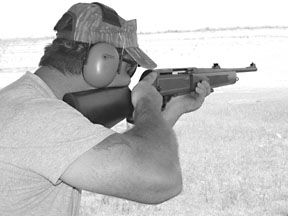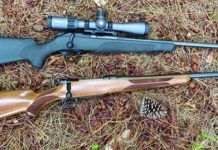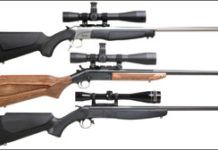
According to Gun Digest 2002, there are at least 42 semi-automatic rifles chambered for centerfire calibers available today. But how many of them are classified or readily identifiable as hunting rifles? By this we mean a non-military appearance, available with barrel length of approximately 20 inches or more, and a two-piece stock with receiver drilled and tapped for mounting a scope. The answer is seven. (Eight, if you are willing to include the Ruger Deerfield 99/44 carbine, based solely upon its name.) Among this short list are the Browning BAR, or Browning Automatic Rifle, and the HK SLB 2000, both of which are available chambered in .30-06 Springfield.
The beginnings of this cartridge can be found as early as 1903 when Winchester chambered the Cartridge Caliber 30 in the 1895 lever-action rifle. The name .30-03 is an acronym of the bullet diameter, which measures just over 0.30 inch, and the year, (19)03. Three years later, after a series of ballistic tests, the U.S. Army decided to modify this cartridge by shortening the neck of the case and loading a shorter bullet with a sharper point. In its 1906 form the .30 caliber (now .30-06) was capable of driving a 150-grain bullet 2700 fps. Recognized as adequate for any type of North American game, the .30-06 remains popular despite the introduction of hotter magnum cartridges.
GT was attracted to the BAR rifle not just because of the continued popularity of the .30-06 but also because of its storied past. Military variations of the BAR rifle have included fully automatic fire. But the .30-06 BAR is perhaps an even more storied weapon in the world of crime and punishment. It could be said that the BAR is linked inextricably to both the rise and fall of Bonnie and Clyde. Known to be the favorite gun of Clyde Barrow, the BAR played a central part in an historic episode of the Texas Rangers (see accompanying sidebar).
In contrast, the Heckler & Koch SLB 2000 is a newcomer, but is nonetheless a variation on the theme of the BAR. Curiously, the HK rifle may have arrived with a low capacity two-round magazine in place, but 10-round mags are available. Is this a nod to its defensive (and offensive) capability? With plenty to pique our interest, we stocked up on ammunition and headed to the range. Here’s what we found.
Browning BAR Lightweight Stalker .30-06, $809
The Lightweight Stalker (LS) version of the BAR is distinguished from other models primarily by its polymer stock. This not only makes it lighter and easier to carry, but weatherproofs the gun as well. It is available in cartridges ranging from .243 Winchester to .338 Win Mag. In our research we found that models varied in weight according to caliber. This signifies that Browning is paying close attention to the structural integrity necessary for the heaviest rounds, but not burdening the shooter who purchases the .243 with a payload built to withstand a heavier magnum cartridge.
Our BAR LS weighed 7.5 pounds, or 1 pound less than the HK rifle. In terms of handling, the addition of the polymer stock gave the BAR a muzzle-heavy balance. The pistol grip was thinner than we like, and this was in stark contrast to the stock on the SLB 2000. The safety was the familiar crossbolt style behind the trigger, and the slide release was located on the right side directly below the bolt handle. Just ahead of the trigger guard was the magazine release, which swung open readily, exposing the follower. One advantage of the design was that it stays connected to the rifle and can’t get misplaced in the field.
Supplied sights are a hooded non-adjustable post dovetailed into a stanchion up front and a fully adjustable rear unit placed just 2 inches ahead of the receiver. This produced a sight radius of 18 inches, which was significantly longer than the one found on the HK. Both units were removable, including the entire stanchion assembly up front. The BAR was drilled and tapped for a scope mount, and parts are readily available and cheap. We paid less than $10 for Weaver scope mounts to fit the gun.
The BAR’s trigger movement was acceptably smooth, with enough travel to provide a helpful level of feedback. We found nothing about the trigger press to be overtly distracting or unpredictable.
Both the HK and Browning rifles were gas operated rotary-bolt designs. In each case we found recoil to be increased whenever the gun was run dry. This was because when the gun fires, it chambers another round, and the rearward motion of the gun was slightly offset by the force of the returning bolt. With the magazine dry, the bolt flies back and stays there. Second only to most magnum cartridges in power, the .30-06 produces considerable recoil. We felt that the BAR recoiled somewhat more than the SLB 2000. While action design and index of stock to body play their part, we would blame any increase in felt recoil to the significant difference in weight presented by the BAR’s lighter polymer stock. In terms of accuracy we felt that our ability to control recoil had an effect on point of impact. Simply put, if you let either one of these rifles recoil upwards on one shot but control it better on the next shot, there can be a significant difference in group size.
At the bench we’re trying to hold and fire without our grip interfering with point of aim and causing deflection. Mounted atop sandbags guns tend to bounce. Heavier-recoiling guns call for a great deal of attention for consistent fire. From a standing position we found that recoil and point of impact were directly related to technique. Careful placement of the butt in the shoulder pocket and how high we held the strong side elbow had a lot to do with consistent points of impact.
[PDFCAP(2)]Our test sessions were held over a three-day period. Days one and two consisted of neutral wind and light conditions, wherein one full day was devoted to each gun. Test firing at 50 yards was accomplished using the supplied (open) sights. Day three proved less shooter friendly, with windy conditions of approximately 20 mph blowing downrange and left. We relied upon Nikon’s new Team Realtree 15-45X60 spotting scope to help us verify the bullet impact points.
This was the day we mounted a scope on the BAR and fired at 100-yard targets. At fifty, the BAR delivered the only sub 1-inch group of our test, firing the 125-grain Winchester Pointed Soft Point cartridge. Overall groups ranged from 0.9 to 1.6 inches. Measurement of largest and smallest groups proved remarkably similar at 50 yards despite the use of three different bullet weights (125, 150, and 165 grain). On average, group sizes for all shots fired varied from 1.3 to 1.4 inches. For the 100-yard shots we mounted a Nikon Monarch UCC 3-9X40. Firing the 125-and 165-grain rounds, our average group sizes remained the same at 100 yards as they had at 50 yards, except for the 150-grain Power Point groups, which swelled to 1.7 inches. But we felt the keynote of shooting the BAR Lightweight Stalker was its consistency. We never had a moment’s trouble loading the magazine, running the bolt or locking it back, operating the safety, adjusting the iron sights, or mounting a scope.
Heckler & Koch (HK) SLB 2000, $1,399
The HK SLB 2000 was comparable to the BAR because it presents the same package (gas-operated semi-automatic fire of the .30-06 cartridge) with only slight variation. It has a two-piece stock (albeit wood), loads from a box magazine, comes with open sights in place and was nearly the same size. We felt the weight of the gun and the design of the stock made the HK more comfortable to shoot than the BAR. The fine wood stocks loom large, and its pistol-grip design were a big hit with our staff. Sling swivels were provided. We also liked the layout of the controls. The safety was at the rear of the receiver and immediately available to the strong-hand thumb. The slide release was located on the left side just behind the forend and was easily reached by the weak-side thumb. If you are left-handed, the slide release can be found easily by the middle finger of the right hand should the rifle be mounted to the left shoulder. This arrangement was exactly the opposite of the BAR. Given the thumb-operated safety, we felt the HK was more neutral in terms of left- and right-handed shooters.
Though both the BAR and SLB 2000 feature free-floating barrels, the gap between the HK’s forend and the barrel was huge when compared to the Browning. This was underscored when, after some initial firing, the forend came loose. The two bolts under the forend were not loose, but the problem persisted. It turned out that these two bolts (metric, by the way) only attach the wood to a rail that was suspended cantilever style from the receiver. To reach the bolt that secures the rail and tighten it properly, one must remove the wood from the support rail, secure the rail, and then reattach the forend. After we tightened it down once it did not come loose again. Our HK arrived with a two-round magazine which was legal for hunting in all states. Five- and ten-round magazines are available for the standard-caliber SLB rifles while magnum caliber models are limited to boxes of two-, four-, and seven-round capacity.
The ten-round magazine ($42 from HK) brings up the question of whether or not this rifle was also intended to be a defensive weapon as well as a hunting rifle. The proposition of a rifle in .30-06 being effective in the field and “in the trenches” was appealing. Keep in mind that at an MSRP of $1,399, this rifle was considerably more than several AR15 rifles, not to mention the BAR. Regarding additional capacity for the BAR, we currently know of no high-capacity magazines available that will adapt to the BAR.
At the range we discovered that the trigger movement was longer and softer than the BAR’s. In fact, the SLB’s trigger had a smooth, almost non-mechanical, sweep to it. We felt that the sights could have been mounted farther apart. We assume that the forward placement of the rear sight was to allow for mounting a scope without removal of the sights. The rear blade was dovetailed into place and drift adjustable for windage only. Elevation could be adjusted at the front sight by installing an alternate blade, which was pinned, and spring-loaded to prevent damage, but extra sight blades are not supplied. The open sights seemed to be adequate, but we ran into a problem trying to mount a scope.
We tried our local retail store, and none that fit the HK were available. As a courtesy the salesman called his HK distributor and was informed that a scope rail would cost $372! We called around on our own and was told that Millett would soon be releasing a mount that would sell for about $75. However, after checking repeatedly with Millett this product was still not available. We did try calling HK ourselves and was promised a mount (reportedly built by B-Square). It didn’t arrive in time to include it in this evaluation. In the SLB 2000 manual the text referred to a telescopic mount. This seemed overly complex, and we deduced that this referred to the $372 mount. The manual also says that a Weaver mount can be assembled, but perhaps that meant that your local machinist can easily adapt a Weaver blank. We don’t doubt this, but we didn’t feel it was our place to fashion a custom part for this test. It would seem to us that a $1400 rifle should either come with a mount or have one readily available at a reasonable price. This prevented us from mounting a scope and recording test data from 100-yard shots.
The only other sticking point in terms of design on this rifle was magazine insertion and release. We found operation of the release to be awkward. Furthermore, the magazine handled reasonably well when it was empty, but once loaded it became difficult to seat. Inserting the magazine required holding the release open and pounding the mag into place. How or why this situation would improve with the application of ten-round magazines was difficult to imagine.
Neither of the guns presented any malfunctions. In terms of accuracy, the HK lagged behind the BAR by nearly a half-inch firing the 150- and 165-grain rounds. Both rifles did their best shooting with the 125-grain rounds. We theorize this was because the lighter round produced less recoil and less barrel heating.
Velocity and muzzle energy readings were very impressive, with the BAR being able to push the bullets slightly faster. The HK’s shorter barrel (2.3 inches) should account for some of the difference in velocity.
Gun Tests Recommends
Browning BAR Lightweight Stalker, $809. Buy It. This rifle does everything it is supposed to. The BAR was perfected long ago and it shows, delivering ease of operation and near MOA accuracy with a variety of ammunition.
Heckler & Koch SLB 2000, $1,399. Conditional Buy. We feel the trigger and overall feel of this rifle are superior, yet it was hindered by the lack of a suitable scope mount. The SLB 2000 still needs some finishing touches despite its high price.
Also With This Article
[PDFCAP(4)]






























